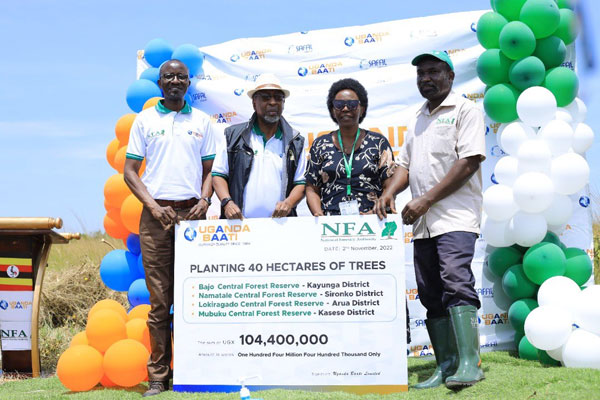
COMMENT | IAN RUMANYIKA | As world leaders often gather to discuss alarming climate concerns, including the most recent Conference of Parties (COP) gathering in Cairo, Egypt, it serves everyone in the manufacturing sector well to remind ourselves of the long-underappreciated duty among those who manufacture, to consider the environment. Green manufacturing has been defined as a commitment to using fewer environmental pollutants and natural resources.
By way of reminder, Africa attracts some of the largest foreign investments yet little correlation is often made to our gains in green manufacturing. UNCTAD for example estimated an 83 billion rise in investment on our continent in 2021, (and that was in the wake of the COVID pandemic). That usually means that as low production costs entice investors, the environment on the continent of so-called “industrialization latecomers” is often the grass that suffers when manufacturing elephants get into business. Arguably so, many in the manufacturing sector on our continent, have barely acted upon any strong climate ambition, if any.
An evident trend is observing factories in Uganda today that inhibit a space once occupied by a water reservoir or a swamp and those that deplete water resources and practice poor waste management. Yes, employment is often the promise, but what often happens to the ecosystem that previously sustained the community they are seeking to empower with jobs?
It’s probable that many manufacturing plants today in Uganda stand where actual tree plants did. Company locations today that were once hosted by nature, are now supporting steel foundations of warehouses, constructed where water was supposed to flow, for example. Not that warehouses are a bad idea, (after all, Uganda Baati has empowered many Ugandan households with next-generation building materials often safely preserved for and in warehouses- using our pre-fabricated buildings, SAFBUILD®, the world-class pre-engineered steel building (PEB) system; designed, manufactured and supplied as complete buildings fast to erect, optimized, durable, and convenient to construct, suitable for schools, churches, warehouses, office buildings, etc.
A recent report by Switch Green Africa, a green manufacturing Advocate, indicates areas of improvement towards green manufacturing as ”water and energy efficiency, improved waste management including industrial symbiosis (IS) and enhanced management of inputs.” The report also emphasizes that green manufacturers transition to sustainable manufacturing through investment in green technology, water, and energy efficiency. It also recommends alignment of policy and regulatory environment among others.
This is a call we must embrace, a sector that prides itself in contributing to employment must also demonstrate sustainable strategies, especially if reports of Uganda’s carbon emissions stand as they do, at an average of 0.13 per capita, last time I checked. This is something to alarm us. I encourage all in the manufacturing sector to take heed. And yes, working to favor the environment is not at a loss, it affects the bottom line too. We recently signed a Memorandum of understanding with the government forest body, (NFA), to replant 40 hectares of indigenous trees across the country, coming up to a total of 10 hectares per region across all Ugandan regions.
These are going to be visible climate action points of us across these regions. We all cannot pay a blind eye to the green effort that should accompany our work. Untended soil has often made mere rainfall turn into deadly floods, as crop yields dwindle, it’s possible for those who mean well, to generate a disaster unawares.
My friend Paul Musamali at NFA for example underlines this predicament stating how Uganda’s forest cover has been dwindling over the years. In the 1900s, the forest cover was 53%, by 1990, it had reduced to 24%; by 2017, it was 12% and between 1990 and 2017, Uganda had lost over 2.4 million hectares of forest cover. The resulting intended soil cover has often turned rainfall into deadly floods, as crops yield dwindle too.
Paul states that eventually in 2019, there was a slight recovery in forest cover to 13%. These are the recovery gains we have deliberately been part of as Uganda Baati, we are leaders in green manufacturing partnerships that are committed not only make Uganda great but create a bright tomorrow for our future generations.
Bajo Forest Reserve restoration, courtesy of Uganda Baati Limited.
Superior Quality Since 1964 pic.twitter.com/71NXDYomX8
— Ian Rumanyika (@irumanyika) April 4, 2023
Thankfully, this corporate forest initiative has made been possible through the committed, green-aware leadership of the Safal group, a leadership we are thankful for in these climate-aware days. With our recent building solution innovation of ULTRASPAN, a designed manufactured & supplied light gauge steel trusses, that is replacing the traditional timber for roofing. We continue to research and innovate, in a bid to provide climate-friendly building solutions.
We hope our effort will also re-energize the long-term conversation about foreign investment players and the role we play in sustainable manufacturing. Eye in the Wild is another initiative of the Safal group that seeks to leverage the beauty of nature and endorse it to various audiences by rewarding exceptional photographers who exhibit the highest expertise in capturing nature photography, it’s worth looking up on our Safal website.
In addition, as a parallel campaign in light of our green manufacturing goals, we recently collaborated with Uganda Hockey in a campaign dubbed “Score a Tree” campaign. The effort seeks to ensure a tree is planted, whenever a hockey goal is scored across the season. We are proud to add this too on our climate-active bucket list. Exceptionally notable too, National Forestry Authority has already identified 5 hectares within Mabira Forest for the Score a Tree campaign, where our partnership will focus its restoration activities in 2022.
Responsible manufacturing requires such commitments. Our efforts are internally guided by four key focus social investment pillars that include: Environment, Shelter, Health, and Education. The recent engagement with NFA comes under our Environment pillar and we are optimistic this initiative will contribute to the realization of Sustainable Development Goals 13 and 17 of climate change and partnerships.
Our leadership steered by the board chairman Dr. Alan Shonubi has since re-energized the company’s commitment to lead the way in green manufacturing. Because we are convinced this country’s future is uniquely safeguarded through environmental protection, we can always do something before it is too late.
At large, all manufacturing sector players ought to do something before it’s too late. our people’s futures depend on our actions, in other words, the talk must end, and the walk must begin. Or put differently, we must walk the talk.
*******
 The Writer, Ian Rumanyika, is the Head of External Affairs at Uganda Baati Limited
The Writer, Ian Rumanyika, is the Head of External Affairs at Uganda Baati Limited
 The Independent Uganda: You get the Truth we Pay the Price
The Independent Uganda: You get the Truth we Pay the Price




I would love to become a columnist for this magazine. My areas of specialization are into environmental management and policy-making & protection, water and wastewater treatment, Quality assurance and control, manufacturing and process control, environmental pollution, and many others related to environmental engineering. I’m a researcher and doctoral student here in the US but a Ugandan.